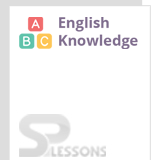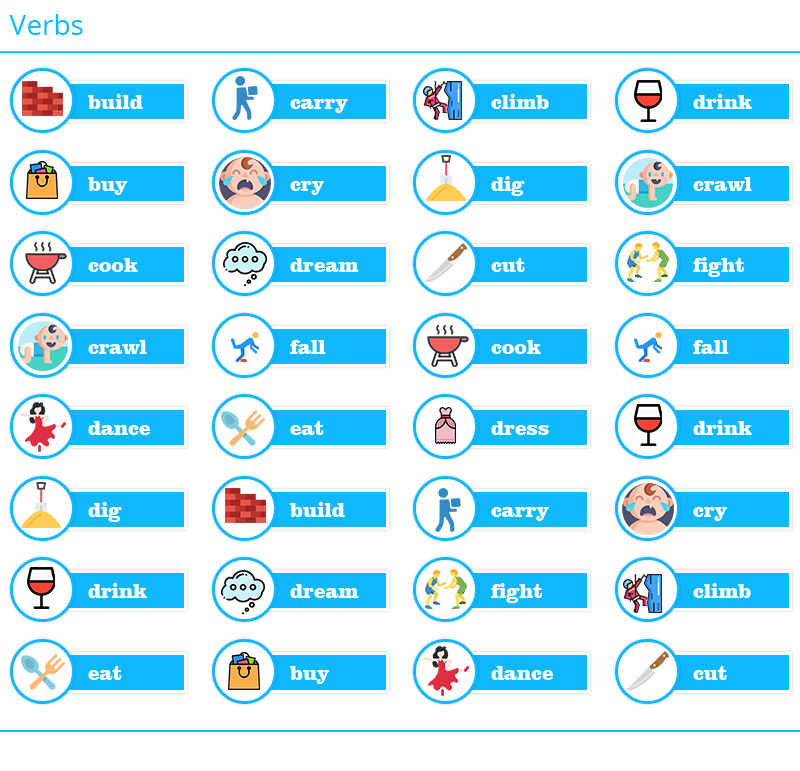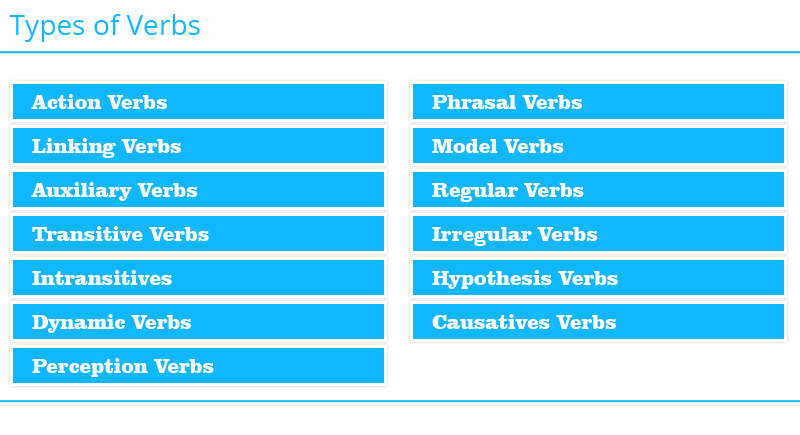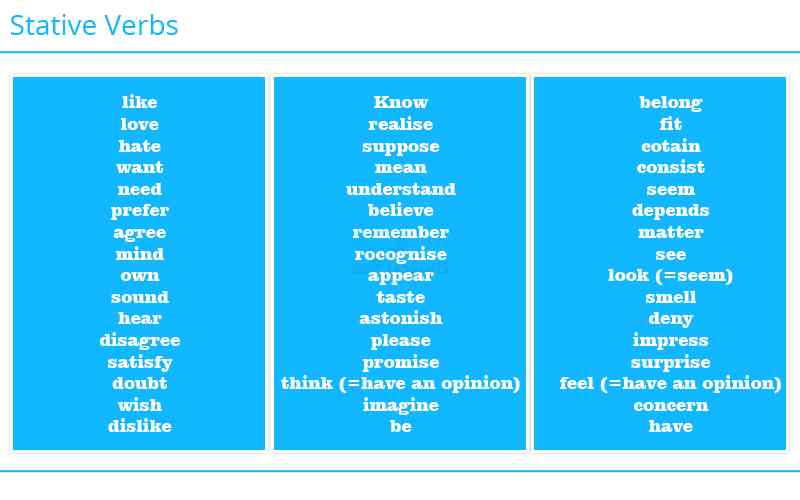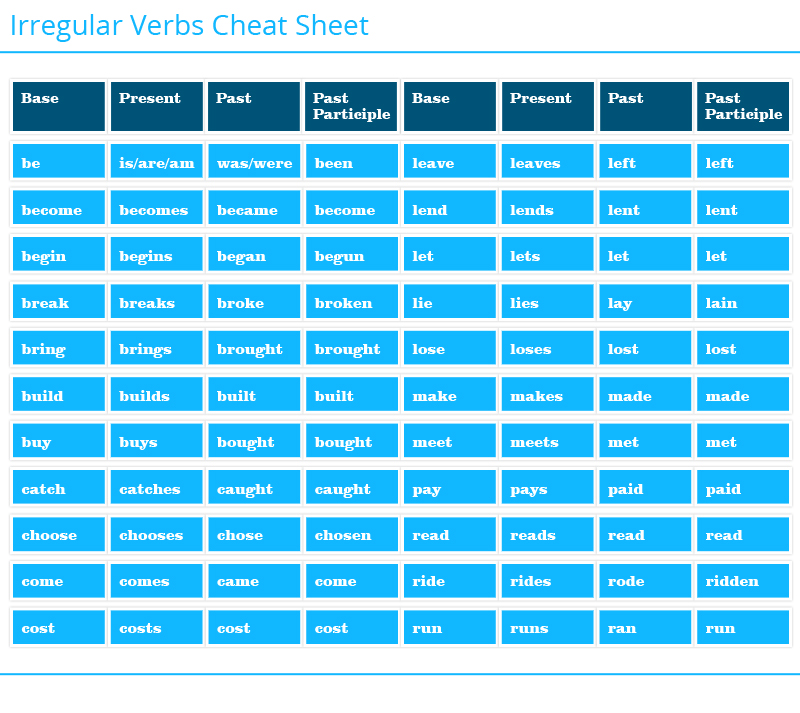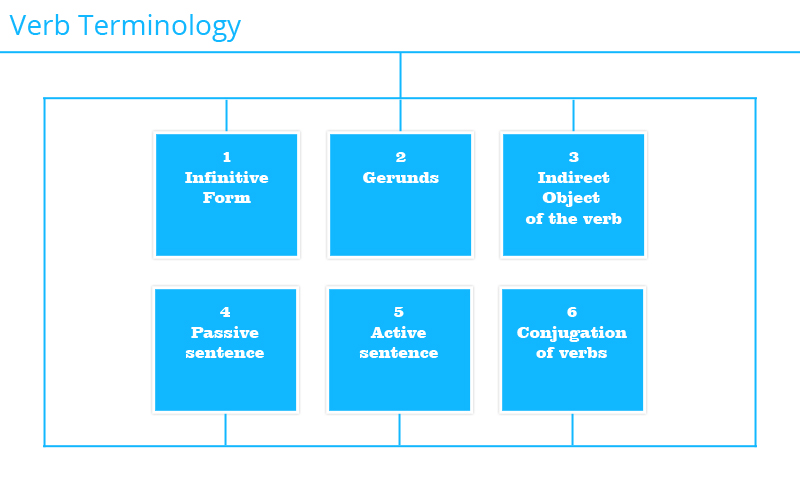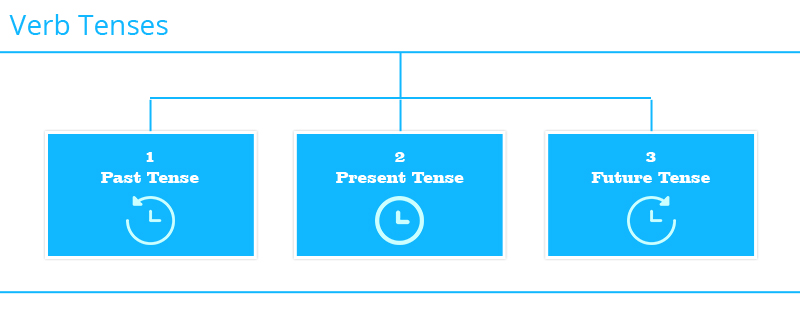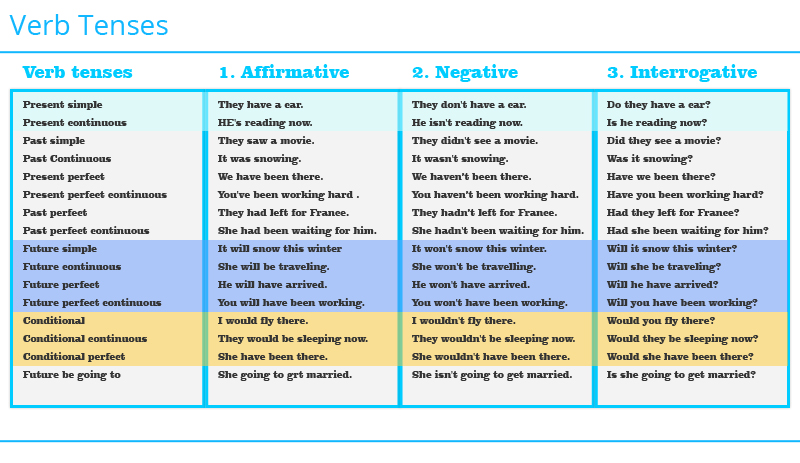 Introduction
Introduction
 Categories
Categories
Categories of Verbs:
Verbs are of different types which are as explained below.
Action Verbs:
A verb that expresses an activity being done by the person is called an Action Verbs.
For example:
Linking / Copular / Predictive Verbs:
A verb that develops a relation between the subject and the predicate without an action is called a Linking Verbs.
For example:
Auxiliary/Helping Verbs:
As the name suggests, these verbs help the action verbs and the linking verbs. Helping verbs cannot be used as alone in the sentence.
Perception Verbs:
Those verbs which describe the five sense organs are called Perception Verbs.
For example:
Irregular Verbs:
Verbs which don’t necessarily take the ‘ed’ form to make their past tense or past participle tense are called Irregular Verbs.
Some instances of irregular verbs are shown below.
Hypothesis Verbs:
Verbs which are followed by subjunctives are called hypothesis verbs. In such cases, we wish against the present facts and the past facts.
Wishing against the present fact in the present examples:
| Example | Explanation |
|---|---|
| Bob is throwing the basketball. | In the sentence, throwing is representing an action being done. |
| She rode her new bicycle every day. | In the sentence, rode is representing an action being done. |
- I am giving the book to her.
- Rita felt sleepy after eating the lunch.
| Action verbs with no helping verbs | I ate five apples. | Here, ate is the action verb. |
| Action verbs with helping verbs | Now my wound will hurt the entire day. | Here, will is the helping verb and hurt is the action verb. |
| Two helping verbs with an action verbs | I will be going to the market with my mother. | Here, will be are the two helping verbs and going is the action verb. |
- Rabia is writing an e-mail to her boss.
- Have you finished your food?
- I will give my interview to today.
- I saw the little boy crying in the park.
- The guests drank the lemonade.
- The boy hit his sister.
- I am with my friend having lunch.
- He believes in Karma.
- The grandfather was the showing the painting to the guests.
- The client negotiated the cost of the project.
| She is an intelligent teacher. | In this sentence, ‘is’ is used as a stative verb. |
| She is teaching intelligent students. | In this sentence, ‘is’ is used as a dynamic verb. |
- I smell the food being cooked.
- He could see the child creating a mess.
- The people are talking about the issue.
- The thief broke in through the window.
- Dylan can eat the ice cream. Here, idea of ability is being expressed.
- Aman should give you the cake he bought. Here the idea of obligation is being described.
| Regular Verbs | Simple Past Tense | Past Participle |
|---|---|---|
| Love | Loved | Has loved |
| Hate | Hated | Has hated |
| Irregular Verbs | Simple Past Tense | Past Participle |
|---|---|---|
| Tell | Told | Has told |
| Bleed | Bled | Has bled |
- I wish that she helped her mother. This sentence clearly gives the idea that she does not help her mother.
- He wishes that he would have accepted the offer letter. This sentence gives the idea that he did not accept the offer letter.
- I wish that he had taken the order. This sentence clearly gives the idea that he did not take the order.
- I wish that I had been in the New York City. This sentence gives the idea that I was not in the New York City.
 Terminology
Terminology
The Grammar Terminology attached to the verbs is crucial in understanding the fine usage of verb forms.. Below the most widely used terminologies have been explained.
The Infinitive Form:
A verb is in its infinitive form when the word ‘to’ precedes the verb.
Indirect object of the verb:
The thing or person for whom the action is being done is called an indirect object.
- I have to do homework. In this sentence, to do is in the infinitive form of the verb.
- I have to eat dinner. In this sentence, infinitive form of verb is to eat.
| As a subject of the verb | Dancing is one of my hobbies. | Here, gerund dancing is the subject of the verb. |
| As an object of the verb | Mike likes playing on the team. | Here, gerund playing is acting as the object of the verb like. |
| As an object of preposition | I am thinking of going to a movie. | Here, gerund thinking is behaving like the object of the preposition ‘of’. |
- My friend is baking a cake for her father. In this sentence, father is the indirect object.
- The thief was arrested. In this sentence, the thief is not doing any action but the action of being arrested is done to him.
- The children broke the vase. Here, children are the subject.
- We will go together.
- You have to go to the school.
- They have arrived.
 Verb Tenses
Verb Tenses
Verb Tenses:
There are three tenses that are used by the people in daily life; they are past, present and the future.
Past Tense: When the sentence represents an action that has already been done, the sentence is said to be in the past tense.
- I walked to the beach.
- My sister ate all the chocolates.
- Tina never picks her utensils after eating.
- The sister kisses her baby sister.
- I will get married to the man of my dreams.
- I will go to Bali in the summer vacation.
 Rules
Rules
Rules for Using Verbs:
There are some rules to be kept in mind while using verbs. These rules are as follows:
- A singular verb comes with a singular subject and a plural verb comes with a plural subject. Incorrect: The list of guests are ready. Correct: The list of guests is ready.
- Words linking the subject and the verb do not affect the agreement. Incorrect: The dog, who is licking my trousers, are generally very good. Correct: The dog, who is licking my trousers, is generally very good.
- Prepositional phrases do not affect the verb and the subject. Incorrect: The flowers in the garden is very beautiful. Correct: The flowers in the garden are very beautiful.
- The subject is always placed after the verb when the sentences start with there or here. Incorrect: There were a problem with the landline. Correct: There is a problem with the landline.
- It is not necessary that the subjects will come before verbs in questions. Incorrect: where is the pieces of that riddle? Correct: Where are the pieces of that riddle?
- When two subjects are linked with ‘and’ the verb taken will always be plural. Incorrect: The dog and cat is pet animals. Correct: The dog and cat are pet animals.
- If two subjects that is being separated by ‘and’ is related to the same person, then the verb that will be used is singular. Incorrect: Red beans and rice are my grandmother’s favorite dish. Correct: Red beans and rice is my grandmother’s favorite dish.
- Verb used is singular when ‘every’, ‘each’, and ‘no’ is placed prior to the subject. Incorrect: Every student are required to bring this form signed by their parents. Correct: Every student is required to bring this formed signed by their parents.
- Singular verb is used when the subject are singular and are linked with ‘or’, ‘nor', ‘neither/nor’, ‘either/or’, and ‘not only/but also’. Incorrect: Mohit or Sumit are given the responsibility of the project. Correct: Mohit or Sumit is given the responsibility of the project.
- For units of measurement or time, singular verb is used. Incorrect: Five liters of oil is needed to get the generator running. Correct: Five liters of oil was needed to get the generator running.
- Plural verb is used when the subjects are plural and connected by ‘or’, ‘nor’, neither/nor’, either/or’ and ‘not only/but also’. Incorrect: Girls and boys is required to form different queues. Correct: Girls and boys are required to form different queues.
- When one subject is plural and the other is singular, and they are linked by ‘or’, ‘nor’, neither/nor’, either/or’ and ‘not only/but also’ then form of the verb depends upon the nearest subject i.e. If the subject is singular then singular verb, if plural subject then plural verb. Incorrect: Neither the tigers nor the monkeys has escaped the cage. Correct: Neither the tigers nor the monkeys have escaped the cage.
- Singular verbs are taken by indefinite pronouns. Incorrect: Everybody want to be appreciated. Correct: Everybody wants to be appreciated.
- Pronouns like ‘few’, ‘many’, ‘several’, ‘both’, ‘all’ and ‘some’ take plural form of the verb. Incorrect: Few was affected by the Tsunami. Correct: Few were affected by the Tsunami.
- When ‘and’ divides two infinitives then plural form of the verb is used. Correct: To rub the head and pat the stomach require great skill.
- If gerunds are the subject of the sentence, then verb from will be singular. But plural form of the verb will be used in case they are connected by ‘and’. Incorrect: Swimming and playing guitar is my hobbies. Correct: Swimming and playing guitar are my hobbies.
- Singular form will be taken by collective nouns. Incorrect: There are a group of girls chatting near the stand. Correct: There is a group of girls chatting near the stand.
- Singular verb will be used with book title, names of the movies etc because they are treated as singular. Incorrect: The Vampire Diaries are a serial about the vampires and the witches. Correct: The Vampire Diaries is a serial about the vampires and the witches.
- If the noun after ‘of’ is a singular noun, then singular verb is used. If it is plural, then plural verb is used. Incorrect: A third of the state are uneducated. Correct: A third of the state is uneducated.
- To make the word ending with E, erase the E and add ‘ing’ to make it a plural verb. For example: The kids are making a chocolate cake.
- To make a verb ending in consonant vowel consonant plural, we just add ING and double the final consonant. For example: I think I am getting a gift.
- In few cases, we do no double the last consonant of the word ending with consonant + vowel + consonant. For example: The shopkeepers are offering a discount.
- When the word is ending with W, X or Y, do not double the consonant. For example: It’s snowing outside.
- To make verbs ending with IE to plural, add YING to it. For example: The students are trying very hard to understand trigonometry.
- To make a verb ending with consonant vowel and L plural, double the L and add ING to it. For example: I have been travelling to South India for my work.


